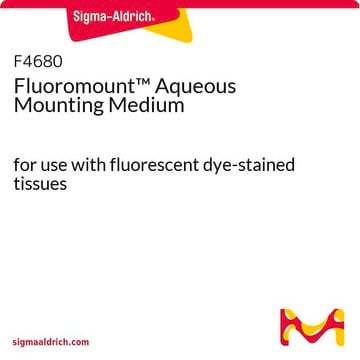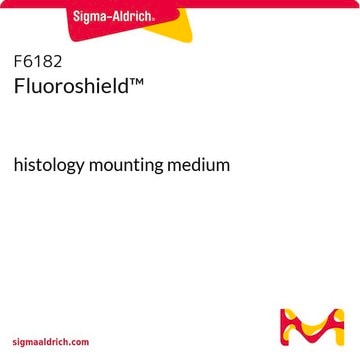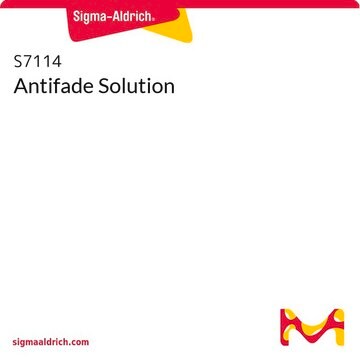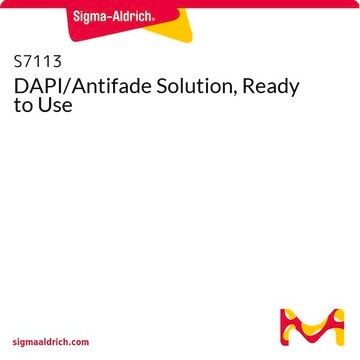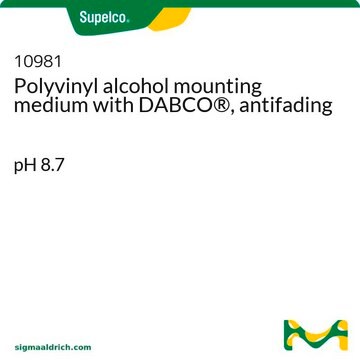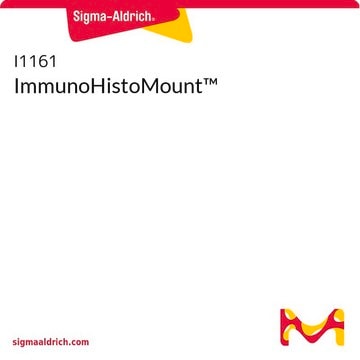Recommended Products
Product Name
Fluoroshield™ with DAPI, histology mounting medium
Quality Level
form
liquid
composition
Sodium Azide, ≤1% (also contains other ingredients)
Tris-HCl
technique(s)
immunofluorescence: suitable
pH range
7.9-8.3
solubility
water: soluble
fluorescence
λex 360 nm; λem 460 nm
application(s)
diagnostic assay manufacturing
hematology
histology
storage temp.
2-8°C
General description
Fluoroshield with DAPI is an aqueous mounting medium fortified with 4′,6-diamidino-2-phenylindole (DAPI), a nuclear counterstain used as a blue-fluorescent DNA probe. It is an anti-fading agent employed for preserving the fluorescence of tissue and cell smears by preventing rapid photobleaching and minimizing the blinking-mediated phenomena.(1) For use in in situ hybridization techniques or other methods where fluorescence of DNA staining is required. DAPI excites at 360 nm and emits at 460 nm, producing a blue fluorescence. RNA is also stained with DAPI.
Application
Fluoroshield™ with DAPI has been used:
- as a counterstain in immunocytochemistry to label nuclei of neural progenitor cells
- as a histology mounting medium for cardiac tissues sections for immunofluorescence studies
- as mounting solution for immunostained heart sections for nuclei detection
Legal Information
FluoroShield is a trademark of ImmunoBioScience Corp.
related product
Product No.
Description
Pricing
Storage Class Code
10 - Combustible liquids
WGK
WGK 3
Flash Point(F)
Not applicable
Flash Point(C)
Not applicable
Choose from one of the most recent versions:
Certificates of Analysis (COA)
Lot/Batch Number
Don't see the Right Version?
If you require a particular version, you can look up a specific certificate by the Lot or Batch number.
Already Own This Product?
Find documentation for the products that you have recently purchased in the Document Library.
Customers Also Viewed
Extracellular matrix-derived extracellular vesicles promote cardiomyocyte growth and electrical activity in engineered cardiac atria
An M, et al.
Biomaterials, 146(1), 49-59 (2017)
Edgar T Hoorntje et al.
PloS one, 13(8), e0203078-e0203078 (2018-08-31)
Likely pathogenic/pathogenic variants in genes encoding desmosomal proteins play an important role in the pathophysiology of arrhythmogenic right ventricular cardiomyopathy (ARVC). However, for a substantial proportion of ARVC patients, the genetic substrate remains unknown. We hypothesized that plectin, a cytolinker
S Hamada et al.
Histochemistry, 79(2), 219-226 (1983-01-01)
DNA-DAPI complexes emit strong bluish white fluorescence when excited by ultraviolet light so that even very small amounts of DNA such as those in mitochondria, chloroplasts, and virus particles can be visualized. Moreover, the staining procedure with DAPI is very
miR-210 suppresses BNIP3 to protect against the apoptosis of neural progenitor cells
Wang F, et al.
Stem Cell Research, 11(1), 657-667 (2013)
Maria L Spletter et al.
eLife, 7 (2018-05-31)
Muscles organise pseudo-crystalline arrays of actin, myosin and titin filaments to build force-producing sarcomeres. To study sarcomerogenesis, we have generated a transcriptomics resource of developing Drosophila flight muscles and identified 40 distinct expression profile clusters. Strikingly, most sarcomeric components group
Our team of scientists has experience in all areas of research including Life Science, Material Science, Chemical Synthesis, Chromatography, Analytical and many others.
Contact Technical Service
